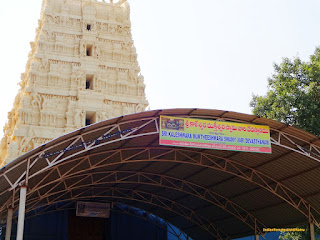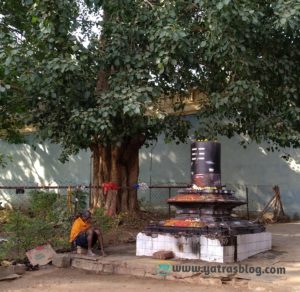 |
| Prowda Saraswati |
 |
| Sculptures on Saraswati's temple |
 |
| Haritha Hotel |
 |
| Sub-shrines around Pradakshinapatha |
 |
| Banks of Godavari and Pranahita rivers |
This famous temple is located in Kaleswaram in Mahadevapur Mandal, near Ramagundam. It is one of the three sacred lingas (Srisailam, Draksharamam, and Kaleshwaram) in Telugu states from which the region got its name as Trilinga. The special feature of this Shiva temple is that one can see two lingas on the same pedestal. To the south of this temple the river Godavari flows in confluence with Pranahitha. So this is called Sangama where the Godavari and the Pranahitha join with Saraswathi that follows underground from the temple. This place is revered as second Kashi and many devotees perform holy ablutions and tarpanams for the liberation of their ancestors. The presence of Kala and Shiva at the same place signifies the rare combination of life and death, implying that life and death are not different.
There is a spacious corridor leading to temple premises. The welcome arch is decorated with two lingams. After passing through the main tower at the entrance, Nandi Mantapa is seen in front of the main temple where one can see a beautiful idol of Nandi. There are four doorways to enter the temple from four directions and four Nandis are seen near four doorways. In Mukha mantapa the idols of Shringhi and Bhringhi are seen. In the sanctum two Shiva Lingas are seen on the same pedestal. The first Shiva Linga was installed by Kala or God of death. The second Shiva Linga is called Mukteshwara which has two holes on its crown. The water poured over this, flows through a secret passage and is said to join the Godavari River outside. Devotees have to worship Kaleshwara first and later Mukteswara as per tradition.
Devotees can themselves enter the sanctum and do pooja and Abhishekam to the main deities. One has to take Rs.300/- to perform abhishekam in inner sanctum. Abhishekam is done here from 7.00 a.m. to 12.30 p.m. and from 3.30 p.m. to 6.00 p.m. Shiva Parvati Kalyanam is done daily from 9.30 a.m. to 10.3o0 a.m. other poojas like Satyanarayana Vratham, Kalasarpadosha Nivarana pooja and Navagrahabhishekam, Navagrahahomam are done here. The temple is open from 4.30 a.m. to 1.00 p.m. and from 3.30 p.m.to 8.00 pm.The temple is crowded during weekends, Mondays and during Maha Shivarathri and during Navarathri festival days.
Adjacent to this temple there is another shrine for Goddess Parvati who is called “Shubhananda Devi.” A little further one can see another temple for Saraswathi with a mukhamantapa. Around the circambulatory path one can see many sub-shrines of gods and goddesses. Idols of Durga, Dattatreya, Lord Vishnu, Sri Kashi Vishveshwara, Sri Bala Rajeshwara, Vijaya Ganapati, Maha Ganapati, Swarnakarshana Bhairava, Kala Bhairava, Sri Bhairava, Veera Bahdra, Sri Kartikeya, Anjaneya, Mastyavatara Murti , Jyesta Devi and Lord Surya. A little further one can see another temple for Saraswathi with a mukhamantapa. The Goddess is named “Prowda Saraswathi”.There is a separate temple for Rama along with Sita and Lakshamana.
There is Adi
Mukteshwara temple just two kms away from this temple. One can see a Shiva Linga
with two holes in the sanctum. The temple priest said that Lord Mukteshwara
moved from here to the present temple after Kala did penance. Here white
Vibhuti stones were found on digging. Now one may not locate them.
In Skandapurana, the Kaleshwara Khanda mentions that River Goddess Godavari did penance here and requested Lord Shiva to stay here and give salvation to people who take bath in the river and worship Lord Shiva. Hence lord Shiva stayed here as Mukteshwara that is one who gives Mukti or moksha to devotees. Lord Kala finding that no one came to his world, requested Shiva to help him. Lord Shiva suggested that he should also install a Shiva Linga on his name as Kaleshwara beside Mukteshwara. Those people who do not worship Kaleshwara first before worshipping Mukteshwara would go to hell. The God of death installed a Shiva Linga (Kaleshwara) beside Mukteshwara on the same pedestal.
As this temple is on the
banks where two rivers which join just like in Kashi, this place is considered as
another Kashi. Just before entering the temple on the western side, one can see
a four-sided arch for devotees to pass through. This is called Yama Konam with Akhanda
deepam called “Ganda Deepam”. People believe that people who go through this
passage are saved from sufferings of Yama Loka. People pour oil into the vessel
containing “Ganda Deepam”. Just a few steps down there is a large area where
one can see an Audumbara tree (fig tree) with a statue of Lord Dattatreya. Many
devotees come here and light lamps and go round the tree.
The temple
was constructed by the Kakatiya king, Rudra Deva in twelfth century. The temple
was constructed in Kakatiya style of architecture. Later Kakatiya kings and
Vengi rulers also worshipped Lord Shiva and developed this temple. In 1140 A.D.
Kakatiya king, Prolaraju II, visited this temple. Vellanki Gangadhara, Minister
to King Ganapatideva, did much to improve this temple. In Kolipaka edict it was
written that the daughters of Sri Vishweshwara Shivacharya, Kundamamba and
Yelamamba (Guru of King Ganapatideva) were said to have installed one thousand
and one hundred and sixteen Shiva lingas here.
Kakatiya king, Prataparudra, distributed gold worth his weight by performing Tulabhara ritual. In 1397 King Devaraya visited this temple and performed Pooja here. Sri Shankaracharya came here and spent some time doing penance here. In 2000 A.D. Sri Bharatitheerthaswamy, Head of Shringeri Mutt, came here and installed various gods and goddesses in sub-shrines and also participated in renovation activities and Mahakumbhabhishekam. The Telangana Government also spent liberally to improve the facilities in this temple. The temple authorities and T.T.D. provide accommodation facilities here. There also many private hotels also to provide accommodation here. It would be better if water and toilet facilities are provided here for the convenience of devotees.
There are not many shelters for devotees to sit and relax. There are
very few trees on the road leading to temple. So, there is much scope to
develop greenery in and around. There are three routes to reach Kaleshwaram.
The route from Hyderabad to Kaleshwaram via Warangal is 265 kms by road and via
Karimnagar is 295 kms. Now there is a shorter route from Chennur and recently
two bridges have been constructed over Pranahita river to reduce the distance
and duration of travel. The road runs through a dense forest for nearly 30 kms. One can enjoy viewing the dense forest where many monkeys are seen playing on the branches of the trees.
+++++++++++++++++++++++++++
11th January, 2022 Somaseshu Gutala







No comments:
Post a Comment